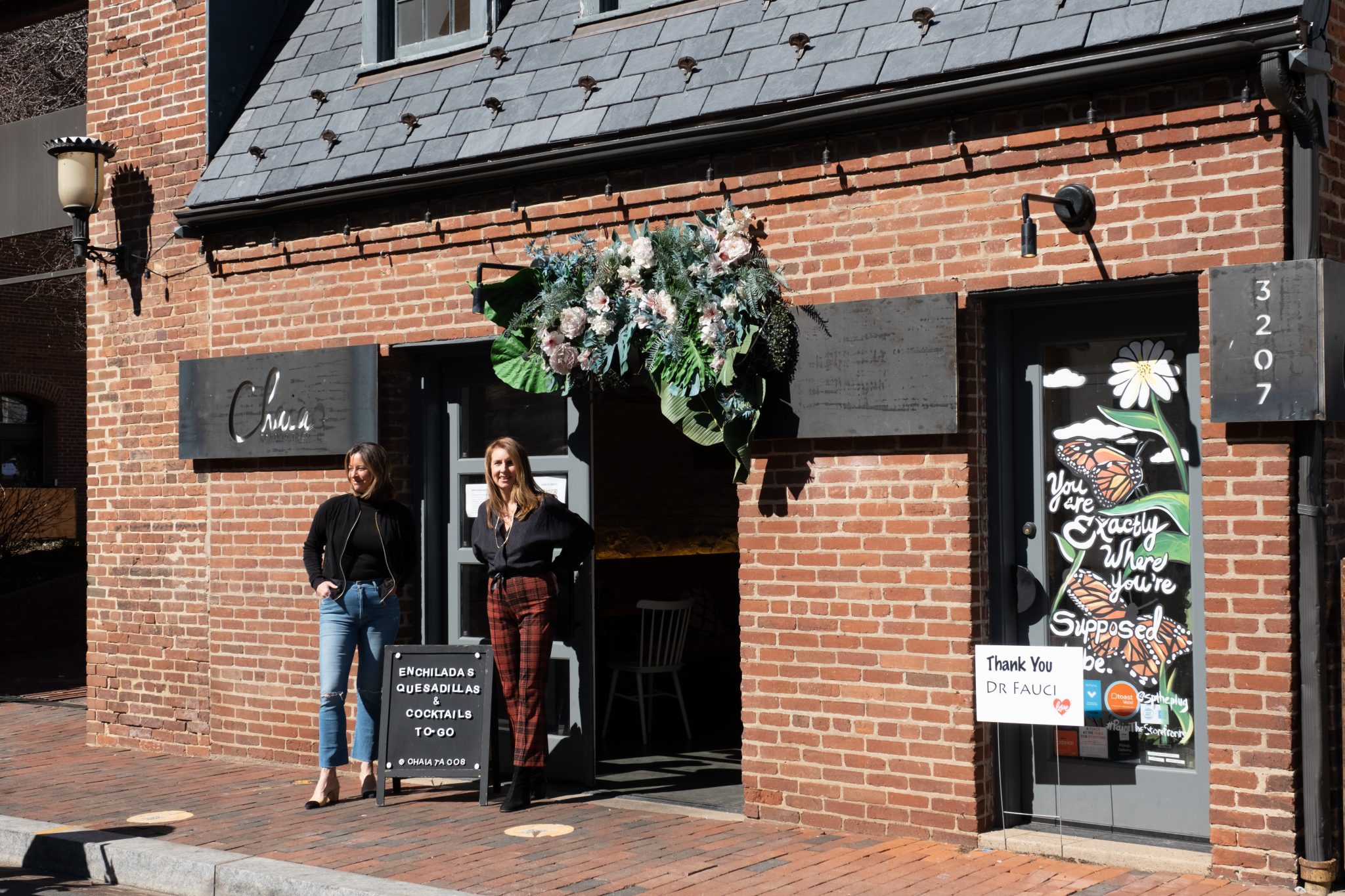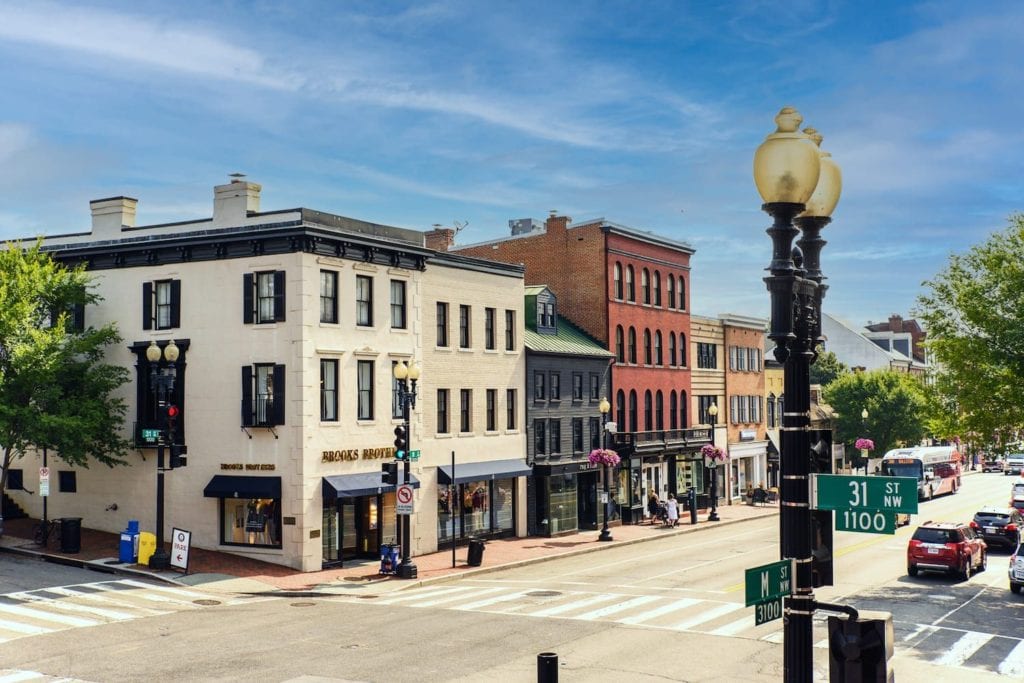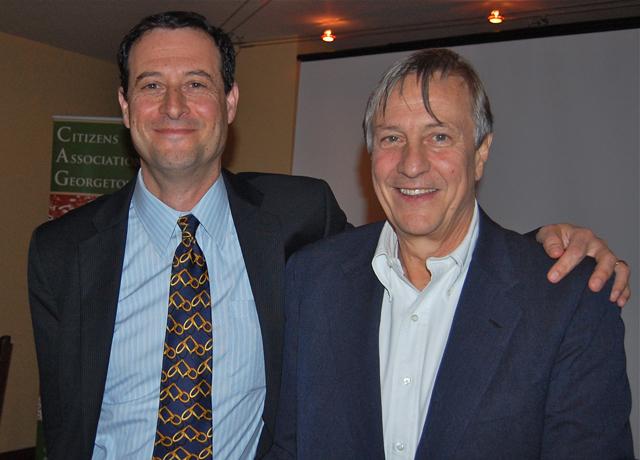Georgetown Retail: Bringing Vibrancy Back
By • March 10, 2021 0 2032

As we begin to imagine the post-pandemic world, creative entrepreneurial minds in Georgetown are exploring strategies for revitalizing commercial market spaces. They are envisioning a return of pedestrian shoppers and new store owners, despite the rise of online consumption in a globalized world. When unique experiences are offered in socially vibrant settings, they believe, people will be hungry to return to in-person shopping.
Attuning to consumer preferences, new technologies, global trends and Georgetown’s unique assets, however, will be essential.
MICROCOSM ON GRACE STREET
In a stone-lined, shaded park overlooking the Chesapeake & Ohio Canal, Bettina Stern, co-founder of Chaia Tacos at 3207 Grace St. NW, emphasized the importance of joining together with customers with a sense of purpose: to help the world shift to more plant-based foods.
Stern described the mission of Chaia Tacos as offering “something new and homegrown and healthy and affordable and that has a social justice mission to feed people delicious vegetables. Saving yourself and saving the planet is integral to who we are as a company and what we’re trying to teach people.”
Just seven years ago, Stern and co-founder Suzanne Simon launched their veggie taco business from D.C.’s Freshfarm Markets. They were one of the first restaurants to stimulate the revitalization of Grace Street, a previously indistinct alleyway just off Wisconsin Avenue, a block south of the canal.
Stern stressed Georgetown’s unique advantages for providing shoppers with vibrant settings. “Georgetown is an incredibly beautiful neighborhood. We’re sitting in this wonderful little parklet adjacent to our stand-alone Georgetown historic building — an authentic, tarnished, gambrel-roofed, perfect-for-our-brand spot — and we’re very fortunate,” she said. “This is a cobblestoned alley in front of us, on a one-way street with all these historic buildings.”
Merging the arts with the shopping experience is an especially compelling idea, Stern said. In the fall of last year, for example, Washington Performing Arts helped sponsor “Dance in DC,” pairing local dancers with small businesses. At Chaia Tacos, “young and beautiful dancer” Ashanté Green performed, she noted, and the event was posted on YouTube.
Across Grace Street, Jessica and Ezra Glass, co-owners of Grace Street Collective, have recruited and helped develop a host of new businesses on the street, including Reverie, Grace Street Coffee Roasters, South Block, Georgetown Butcher and Rapha.
“We created a cool little microcosm of people who go between the Soul Cycle and Sweetgreen, where there’s this little loop where people say ‘I can get a healthy workout in this enjoyable little hangout area,’” said Jessica.
Besides managing significant investment portfolios, the Glasses bring key skills to their commercial real estate work. Ezra has a background in computer programming, data analytics and coding to crunch business data, as well as a Georgetown Law degree. Jessica worked in online journalism and served as Microsoft’s director of marketing for six years before coming to Georgetown.
Together, their savvy, data-driven cultivation of and support for Grace Street Collective’s businesses has created a vibrant hub of commercial activity in just a few years. In 2017, they were recognized by the Georgetown Business Improvement District for helping to put Grace Street on the map.
For Jessica, it’s as much about creating a community market space in a place she and Ezra have come to love as it’s about the numbers. “We love living here and felt there were some things that could be done on the commercial side that could make it more appealing,” she said. When considering a tenant, she first asks “Does this enhance Georgetown?” As a discerning shopper in the area, she wanted to improve the retail offerings available.
In an age of ubiquitous GPS technology, the Glasses realized, consumers could easily find their way to historic back alleyways like Grace Street. With large numbers of shoppers on the main streets, small retail businesses could now draw consumers into new areas of Georgetown. You could create things that weren’t on the primary streets but still gain access to that audience.
For Grace Street Collective, the objective was to find and cultivate unique, highquality retailers and restaurants, unlike the national brands that could be found in every mall — or even on Georgetown’s main thoroughfares — then put them together to create a symbiotic marketplace community.
“We would try to find tenants we thought were really exceptional operators at their specific businesses and help bring them to Georgetown,” she said. The key was to locate tenants who could help make Grace Street a shopping destination. The spot “wasn’t really trafficked at that time, so the idea was that if we could find some ‘destination tenants’ that people would really go to, we could have a group of them together to create a cross-pollination effect.” She added: “If you’re with a group of tenants of similar caliber and it’s high quality, it gives you a sense of empowerment” to work together to help draw customers.
A key to success has been their investment in analyzing the financial data from the firms they’ve cultivated. Some have thrived as startups and “graduated” to other, larger retail spaces owned by the Glasses’ real estate wing, Thyme Holdings, while others have had to reduce their footprints due to the pandemic.
“We really try to understand their businesses before bringing them in,” she said. “We think it’s really good for Georgetown to put the time in to ask ‘Who would really thrive here?”
Since the Glasses also own and operate Grace Street Coffee Roasters, they have their own experience-based and “tenantcentric” perspective. They understand what small retailers are going through in the marketplace. With an eye on quality products as well as performance, however, she believes Grace Street Collective can’t go wrong.

At the corner of 31st and M Streets NW, EastBanc is opening a
“retail laboratory” in the former Brooks Brothers space.
EASTBANC’S RETAIL LABORATORIES
Major commercial real estate interests in Georgetown and the District have also modified their strategies in the wake of the pandemic and the nationwide shift from bigbox retail to online sales. Anthony Lanier, CEO of EastBanc — which leases a majority of commercial real estate space in Georgetown — has experimented with innovative practices to meet his firm’s goal of “filling all [their] Georgetown storefronts in 2021.”
Instead of waiting for businesses to approach EastBanc, Lanier’s team actively searches online for potentially successful businesses to recruit. And instead of offering traditional leasing terms, they seek to develop vibrant marketplace environments where startups can be incubated together in former big-box spaces. Shoppers will be attracted to the diversity of local offerings from multiple small vendors in roomy, well-designed spaces, as opposed to the more predictable fare from national-brand retailers.
Key to creating such vibrant marketplaces is to make it as easy as possible for startups to launch — what Lanier calls a “no adversity” environment for entrepreneurs. Highly flexible leasing based on percentage-of sales terms or even payment waivers, as well as maximal logistical support and assistance in hiring staff, is provided. Simplified contracts of only two pages have become the norm.
“Our first goal is to fill these empty storefronts and make it as easy as possible for the people who are willing to take that courageous step and open up a store of any kind. So we’re trying to encourage them by saying rent is not the most important thing at the moment. What’s important is that you succeed.”
Lanier refers to these vibrant marketplaces as “retail laboratories,” where shoppers can enjoy a variety of new offerings and entrepreneurs can test their business models. At the site of the former Brooks Brothers at 3077 M St. NW, EastBanc will be launching one such project, known as 31M, later this month. At 31M, Lanier’s goal is to cultivate “20 to 25 retailers of different sizes … and to generate a flexible environment that can be very attractive to produce high sales per square foot, which will enable the tenants to pay rent.”
According to Lanier, the site lends itself to the project because it has three stories, several entrances and little patios, as well as an elevator for ADA compliance. “So it’s a great store. I look forward to what its opening will bring,” he said. “It will certainly fulfill our goals to have zero adversity to opening a store.”

Georgetown BID CEO Joe Sternlieb and Anthony Lanier
of EastBanc. Georgetowner photo.
Global trends have also influenced Lanier’s approach. EastBanc’s Embaixada property in Lisbon, Portugal, serves as a blueprint for the vibrant marketplace approach. Inside a stunning Moorish palace, shoppers not only encounter a diversity of Portuguese brands, but the world-famous Gin Lovers bar, restaurants and evening concerts. As a marketplace, Embaixada has become a noted European brand itself. It’s a “great success and one of the hottest stores in Lisbon,” he said, “a precursor to what I would like to do” at the Brooks Brothers site.
EastBanc Principal Philippe Lanier described how, once the unique branding of Embaixada took off, world-class vendors sought a space in their marketplace. “Once you get the word out, all of a sudden there are certain very established brands that say ‘I want to be at the heart of that Bohemia,’” he said.
According to Anthony, 31M will be something new, “and the people in Georgetown I suspect will love it and it will make them come out of their house and go to M Street.” Citing the factors of innovation, architecture and “the fantastic support of the neighborhoods,” he said, “this could be a moment where people could rediscover Georgetown.”
For Philippe, the successful rejuvenation of Georgetown’s commercial areas will require the development of innovative mixes of experience-based entertainment (think axe-throwing bars), along with enticing restaurants and retail. The more foot traffic to exciting destinations, the more vibrancy.
“You really need a reason for people to come and just walk the streets. You have to have the energy, right? And that’s where your cupcakes come in, your escape rooms, your restaurants,” he said. “You want to create diversity.” As for axe-throwing: “As crazy as I think throwing axes next to a bar sounds, people like it and they show up.”
To help increase such foot traffic and vibrancy, Philippe is particularly enthusiastic about EastBanc’s current project at 1238 Wisconsin Ave. NW, across from the Apple Store, to be completed by the middle of next year. EastBanc will be “delivering six retail spaces that are all under 2,000 square feet, which is what every small retailer wants. So bam! All of a sudden you’ll have one retailer after another — six stores that everyone wants and that will help revitalize Wisconsin Avenue.”
BOB ELLIOT’S RETAIL-RESTAURANT MIX
But EastBanc isn’t the only major commercial real estate developer in Georgetown experimenting with innovative strategies — and being influenced by globalization. Bob Elliott, owner of Prospect Place, has dedicated himself to boosting the vibrancy of his retail space, which includes Ann Mashburn, Toka Salon, Fitness Together, UPS and the Sandbox. Also in this complex at 3251 Prospect St. NW sit Cafe Milano, Peacock Cafe, Brasserie Liberte and Mai Thai.
Last summer, in the middle of the pandemic, Elliott launched a pop-up outdoor restaurant called Bar Boteco with 80 seats, drawing up to 240 customers on Saturdays. The idea was inspired by one of Elliott’s Brazilian waiters. “A boteco is actually a Brazilian pub,” he explained. “They’re all over Brazil. I didn’t know that myself, actually. A waiter gave me the idea. He was Brazilian and we were all sitting around and he said, ‘Why not try a boteco?’ And I said, ‘What’s that?’ And he explained the whole thing to me.”
The boteco concept brought a new vibrancy to Prospect Place. “It was a success in terms of filling up our property and making it more exciting,” said Elliott. “Good food. Great setting. I think there’s a role for pop-ups in the good weather … I did it to liven up the place because everyone was suffering so much.”
BRING BACK THAT VILLAGE FEELING
John Asadoorian, of Asadoorian Retail Solutions in Georgetown, also believes that replacing traditional generic retail with fresh and unexpected in-person shopping experiences will bring rejuvenation. Over the last few decades, according to Asadoorian, Georgetown began to look like a “sea of generica,” with national retail brands that could be found in any suburban mall dotting the landscape.
“What we lost was the character of the unexpected. And the unexpected is the smaller, independent stores that you don’t find in the malls, that you don’t necessarily find online,” said Asadoorian. “You find them by strolling down the street, or walking your dog or getting a cup of coffee at the local café.” He continued: “So I think that the opportunity is to develop more of the unexpected, the authentic, the local, the unique and the independent. By doing that, we will have created a vibrant Georgetown.”
Asadoorian sees positive transformations, however. He particularly applauds the successful launching of Pacers Running, the local running shoe store at 3273 M St. NW, because it replaced big-box retailer Lucky Brand on the site. “There’s a Lucky Brand jeans store in every mall in the region,” he said. “So why not seed [M Street] with a local, family owned business that’s been around for a long time, that is in a segment that enhances the quality of life?” Pacers Running also connects well with local shoppers by hosting running events and creating a sense of community.
Asadoorian was impressed with the entrepreneurial courage the owners of Pacers Running demonstrated by taking the risk to move in during the pandemic. “Let’s get you in and see if we can incubate a business. And if it works, great, and if it doesn’t, at least we kept the store open and provided everybody with a little opportunity,” Asadoorian recalled thinking when he helped negotiate the Pacers Running deal.
He imagines M Street one day lined with such locally relevant and connected stores: “Imagine if we had more opportunities like that up and down the street. All of sudden Georgetown goes from looking like the inside of a mall to feeling like a true village … a neighborhood that happens to have a super-regional draw.”
AN APPROPRIATE STREETSCAPE
Innovative approaches to revitalizing commercial retail in Georgetown often call for architectural transformations of existing spaces and, consequently, a reduction in the red tape associated with altering historic buildings. In the refurbished Flour Mill offices by the C&O Canal, BarnesVanze Architects helps Georgetown clients find architectural solutions in this challenging environment. Co-founder Ankie Barnes believes successful revitalization in Georgetown will require ongoing vigilance in protecting Georgetown’s unique historical features and scaling, while working to find modern solutions to refurbishing commercial spaces.
Barnes pointed to the design of the new Apple Store at 1129 Wisconsin Ave. NW as a successful model of achieving this sort of balance with the approval of the Old Georgetown Board. “I think it’s a good example of how everything in Georgetown doesn’t have to be old-fashioned to be successful and appropriate,” he said. “They just want scale to be appropriate. So, if you look at the size of the building and so on, it fits in with the streetscape … It’s politely in line with the buildings next to it, some of which are from the 1800s, and it achieves a balance of modernism with the scale of the neighborhood. It can be a modern building in Georgetown without being an affront to the historic scale of Georgetown.”
Barnes believes Cady’s Alley off M Street also successfully blends the historic with the modern. It was “an old historic neighborhood, but it’s been restored and parts of it have been rebuilt in a fairly modern and current manner. And, yet, after one drink, you’ll think you’re in old Europe … so, it’s a very nice plan,” he said.
THE BID: THINKING CREATIVELY
The Georgetown Business Improvement District is also pursuing innovative and creative approaches to revitalizing Georgetown’s commercial spaces, according to CEO Joe Sternlieb. An environmental impact statement is being drawn up for the plan to create a major regional attraction: a gondola over the Potomac River between Rosslyn, Virginia, and Georgetown. To bring people to Georgetown, the BID is spending a lot of time and energy on public art festivals and installations such as “Glow,” the annual exhibition of light art installations, according to Sternlieb. The C&O Canal barge will soon be re-launched and publicized. A proposal for a pedestrian crosswalk at the 3200 block of M Street is also under review.
Sternlieb has been rallying support for Mayor Muriel Bowser’s initiatives to enhance commercial vibrancy by allowing regulated alcohol sales and consumption in select outdoor market areas in Georgetown. The BID is also calling on the city to lift restrictive caps on Georgetown’s liquor and tavern licensing. Promoting #ShopMadeinDC, helping businesses with government regulations and matchmaking commercial realtors and business tenants continue to be priorities.
With over 35 streateries established in Georgetown — said to be the most of any neighborhood in the city — the BID will continue to widen sidewalks to enhance outdoor dining. To improve safety for diners, Jersey barriers have been added. “People, residents and visitors to Georgetown have never been able to dine on M Street and Wisconsin Avenue in Georgetown,” Sternlieb said, “and suddenly they’re really enjoying the experience. And, I think that creates a real virtuous or positive retail cycle as well, because people dining on the street leads to greater pedestrian traffic, which leads to greater retail traffic, which leads to more retail leasing. It’s all very positive.”

